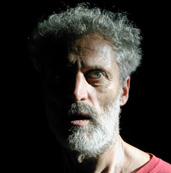NarrAZIONE

On the Work of Gabriele Ercoli
The art of Gabriele Ercoli springs from the myth and poetry of places that stretch from the Sybilline Mountains to the sea and what lies beyond. Its language is drawn from a being in the world that is intent upon continuously passing its beginnings. It explores a new medium, which he calls antimatter, because it points to that which is not.The industrial molecular fiber on whose surface he works – a material at once recalcitrant and poetic – mutely evokes what lies beyond any sonority. Experimenting with it in the series Saggi, he interprets his land, poetically lived, through the filter of the avant-garde (Zolla di Altidona, Marina, Iride). Subsequently, caught between postmodernism, kitsch, and the unstoppable conformism of the spectacle, all paradoxically opposed to the immanent violence of the real, he searches for possibilities outside them. Immersing himself in a “dilated time” (a verse from an early poem that anticipates his trajectory), Ercoli listens to the magnetic silence of an art and an existence going back to the time of the origins. Significant works include: Annunciazione, which heralds the luminous absorbing power of black; NeroLuce, an homage to Matisse, which confirms what was announced by the preceding work; Tabernacolo, Antro, Angelo Anarchico, Sindone di Agamennone, which translate religious thought into the world of power, technology, and history; Trilogia della Storia, Apparizione, in which antimatter, opened up and broken apart, is revealed through a gesture, and art appears before the artist; and Tavole dell’Arte, which articulate the founding principles of all of Ercoli’s work. All are works that revive the economy of gestures and the technical means employed by his ancestors.
In 1988, an illumination before the works of Osvaldo Licini at Monte Vidon Corrado. The sacred: the bricks from the town’s furnace glowing like gold in the magic of the sunset. Works: Trasfigurazione, Astro, magmatic alloys of antithetical chemicals, chromatically filtered through the medium, blossoming forth on its surface.
The same frayed knots of color from Licini’s Missili Lunari, set ablaze by blue, are wrought into Ercoli’s splintered intaglios.
At the turn of 1989, the traumas of the world blind the artist.
Ercoli suffers a double loss: the beauty of the land of his
grandfather, and the beauty of his “Greece” and of lived peasant culture. This is the thinking and this is the beauty that become concentrated in a dystopian fashion in the depths of his art and in the depths of the boards that he fractures with the strikes of his mallet, rupturing their fibers with what amount to the blows of history.
A new language is born: visionary, substantiated by what is contemporary. Works: L’orizzonte di Marco, Rosso sette, FrattiNeri, FrattiNaturali, and the poem, “nel verde selvaggio…” While the flashes of war continue to burn the Adriatic, the artist’s gaze descends toward the east and captures the dramatic passage. (Ercoli meets Teki and Irfan, Macedonian brothers, the former a deserter from the Serbian army who flees through Bosnian forests and makes his way across the Austrian border to join the latter, already a manual laborer in Italy: with them, they bring clandestinely filmed footage of war, of bodies ravaged in the Slavic massacre). From the land of his grandfather to the land raped by everyone (its sky also), the artist looks toward the land of the middle: Mesopotamia.
A work from 1991: Una parete di luna, una finestra di buio. Out of 194 nations in the world, 42 are at war (two billion people). Afghanistan, Kurdistan, Palestine, Syria, Egypt, Libya, Algeria. Work: ArgoFermo, already on the orbit of the crescent moon.
Ercoli’s antigesture breaks against his works to repeat the world’s own violent gesture, going beyond antimatter and smashing it from behind (early work: Dietrosimbolo, 1992).
While its front remains hidden from the artist, the board becomes charged with energy, its molecular fiber strains, tears, explodes,
seems to imitate the friction of the telluric motions of the globe, which oppose each other and at last give way to what lies below (who knows if Ercoli, digging into his board and turning it up as if it were earth, might not also be reenacting the gesture of his pit – digging father, who penetrated the earth’s layers in a spiral, hunched over his spade and disappearing into the threatening dark?)
An endless beginning (P – the title of a drawing executed by the artist in the 1990s as a prelude to Frattocosmo). From the nothingness of the bare board, formless and compressed, the excavation begins again, a mysterious birth that brings each new work to light as it emerges from its black “muteness.” Now, the magnetic work absorbs us, lives suspended in the deafening silence generated by an antigesture that nullifies time, and its chthonic beauty situates us in that which is eternal, capturing in its black fractures and apertures that ancestral howl in the moment of its coming forth. Is this the night of the world?
Gabriele